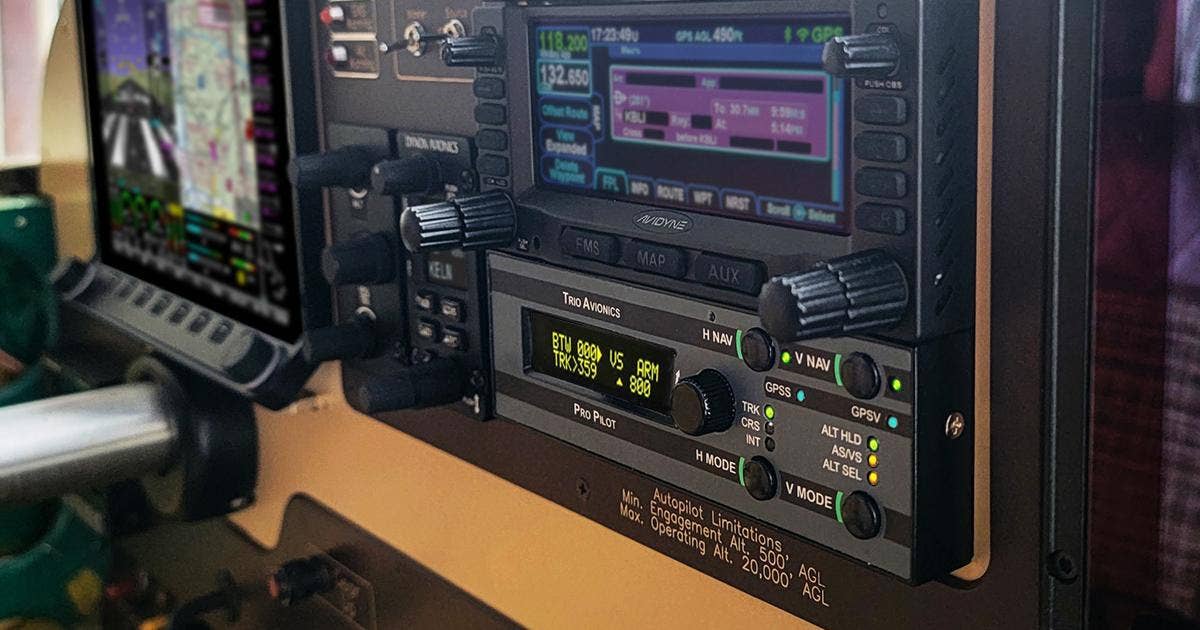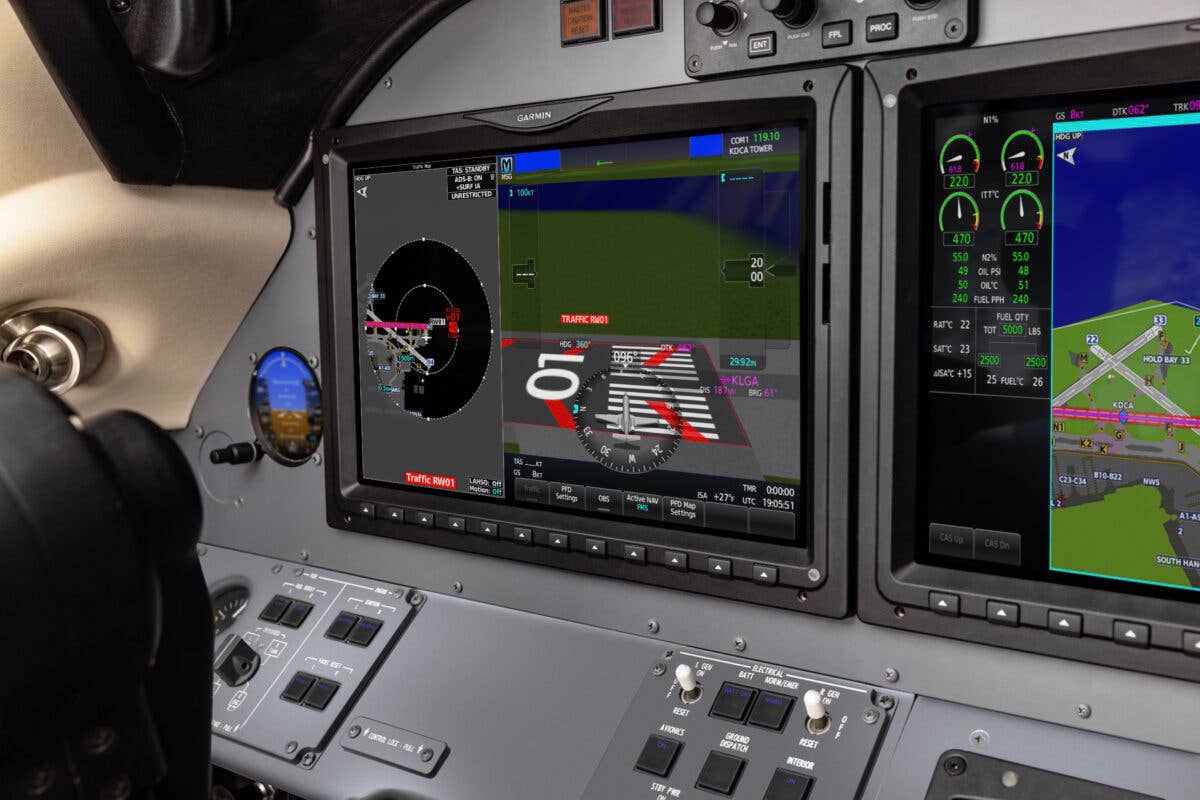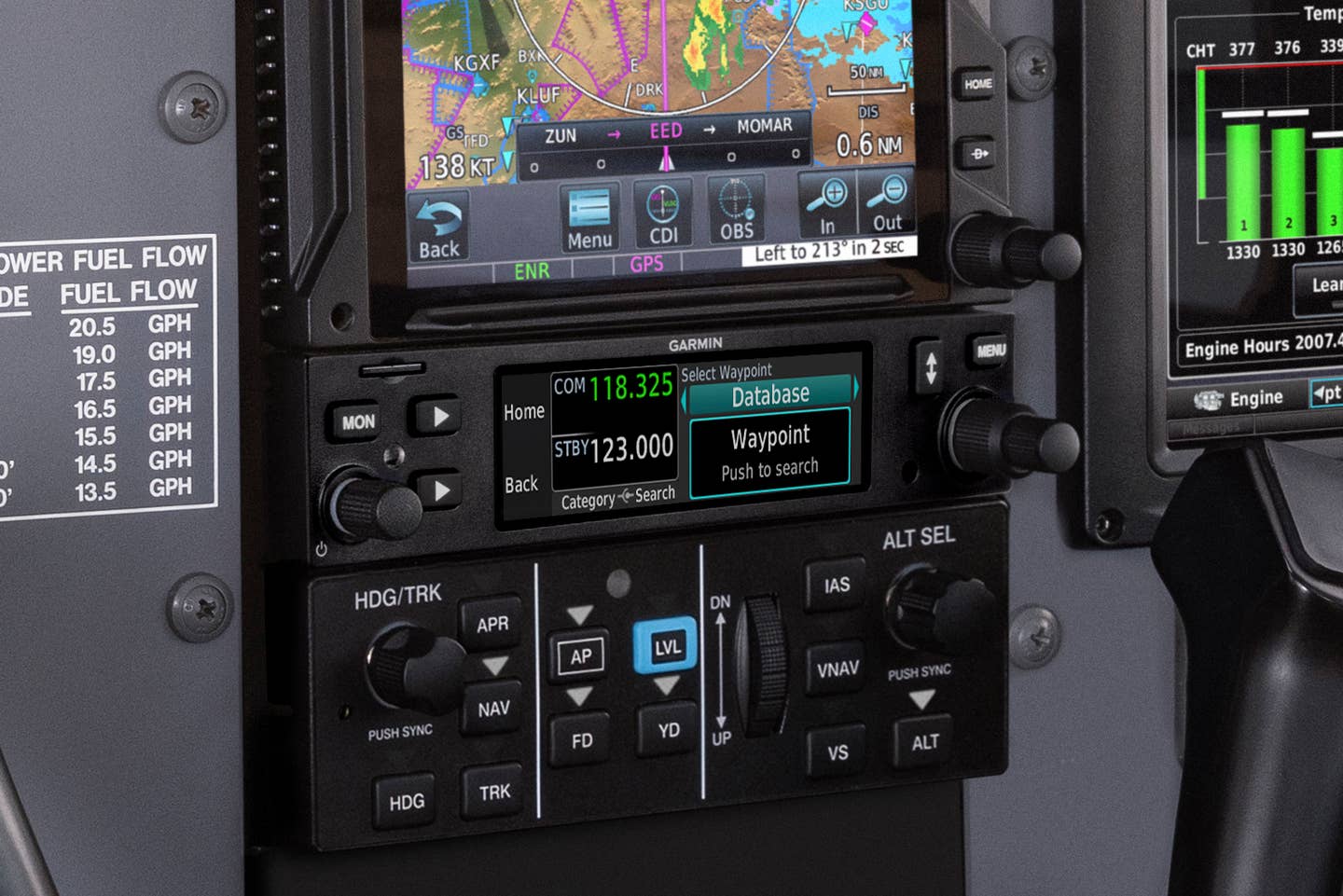Today’s Electronic Flight Displays
Modern PFDs present vital information without the failings of conventional gyros. And they’re ’affordable’ to boot!

Garmin GI 275
For years, the glow of an electronic-display attitude indicator was associated with---and largely limited to---the world of business jets and airliners. Those of us living in the middle tax brackets continued to fly around on gyroscopic flight instruments, whether powered by vacuum or electricity, which were accepted as the industry standard. Most pilots who've logged a certain number of hours have endured a vacuum failure or a failed gyro.
Miniaturized electronics and advances in backup batteries that have emerged in recent years have hit the avionics scene full-on, and the FAA's improving attitude toward approving new technology in the panel has accelerated an explosion of new models available for aircraft owners when the time comes to repurpose gyroscopic instruments into bookends. As clichéd as terms like "game changer" and "disruptor" may be, these instruments have ushered in a new age of reliability and situational awareness.
A Mostly Standardized Layout
The beauty of a good primary flight display (PFD) is that it needs almost no instruction for basic use. The sky is blue, the ground is a brownish-orange, and the rest should just make sense, right? Beyond that, most instruments stick to the convention of displaying altitude to the right of the instrument and airspeed to the left. A window at the center of each "tape" shows the actual speed or altitude, and the tape moves up or down in the background, indicating a trend of climb/descent or change in speed. There are some variations in how different manufacturers present this information on their displays---we'll get into that with each instrument's rundown.
Aspen Evolution E5/Pro 1000/Pro MAX 1000
Starting off alphabetically, the Aspen's offering differs a bit from other contenders. While the other instruments fit the standard hole for a single instrument, Aspen's Evolution line takes up a bigger chunk of your panel: An over-under presentation of attitude and direction indication by a single screen takes up a 3.5- x 7-inch footprint of your panel. As long as you're rocking a standard six-pack panel, you're in good shape, but if you own a nonstandard-cut panel such as older Cessnas or have an angle bent into your panel---we're looking at you, vintage Mooney owners---then you might be looking at cutting a brand-new panel for your Aspen install, which can substantially increase installation costs. The Evolution series of instruments all use the same hardware, so if you install an E5 and get envy after flying a Pro MAX with synthetic vision in a friend's plane, you can upgrade the unit---which ain't cheap---but you'll move up a few tiers without having to tear your panel apart again. All the Evolution units are controlled via a combination of two knobs and a number of buttons along the right and bottom frame of the unit, so their operation is standardized, allowing you to move from one model to the next without much of a learning curve.
With a base price of $4,495, the Aspen E5 is the budget model. It gives you an attitude indicator and HSI display. The Non-TSOed device is installable via an AML (Approved Model List) STC that covers most types of general aviation aircraft lighter than 6,000 pounds. It is directly compatible with the Honeywell AeroCruze 100 autopilot (previously known as the TruTrak Vizion), and with a few adapters, it can interface with a number of vintage autopilots. It's approved for IFR flight when connected to a panel-mounted IFR GPS. While the unit does have an internal GPS built in, installations lacking an IFR GPS will be limited to VFR only. The Evolution 1000 Pro MAX, at $9,995, is the next step up, introducing options for terrain and synthetic vision, traffic and weather display.
Garmin G5
Garmin's first entry in the field was the G5, and compared to some other contenders, it's easy to view it as something of a simpleton. Its STC limits installation to replacing the attitude indicator or turn coordinator when configured as a PFD. So, for a typical certified install, you'd need to keep your airspeed, altimeter, VSI and turn coordinator in place. The altitude selector gives you a target on climbs or descents and keeps you honest in cruise. While there's less information displayed than many other systems, the uncluttered display is basically the same presentation airline and business jet pilots have used for years. It makes an easy reference for pilots, and up to four hours of battery life means that in many electrical failure scenarios, your aircraft's attitude reference will likely outlast the fuel on board.
While the installation can be as simple as providing connections for power, ground, pitot and static, if you have compatible equipment, the display packs in flight directors, annunciators for autopilot commands, and GPS course direction. Garmin's GAD13 interface ties a temperature probe to the G5 to add true airspeed and winds aloft data.
A G5 can also be installed along with a GMU 11 magnetometer as an HSI to replace your DG and CDI. Add in a GAD 25B, and it'll run selected autopilots from Garmin, Century, Cessna, Honeywell, S-TEC and Piper. A G5 DG/HSI also serves as a reversionary attitude display in case your primary attitude source fails.
The G5 fits into a standard 3.125-inch instrument hole, but it mounts from the front to allow a larger 3.5-inch screen.
The G5 attitude indicator is priced at $2,595, and the HSI, when set up with GPS interface, is $3,445. Unlike the newer GI 275, the G5 is sold "over the counter," with an AML STC for installation by any A&P/IA mechanic with no need to deal with avionics shops or Garmin dealers.
Garmin GI 275
Garmin's newer instrument replacement is a Swiss Army knife of aircraft instruments. Again, we'll focus not on its many possible presentations but solely on what it will do when replacing your attitude indicator or directional gyro. (But be aware that with a different software load and some additional interfaces, that same box can serve as an engine monitor, MFD or CDI. In theory, you could build up an entire panel of GI 275s, but by the time you've installed three, you may as well have gutted the instrument panel and installed a G3X system.)
The GI 275 fits a standard instrument hole, and for better aesthetics from behind, so it integrates a little more subtly than is possible with the G5's square form factor. The 275 features a touchscreen interface in addition to a two-piece knob. The limiting factor of the 3.125-inch instrument hole means the screen isn't big, and it's presenting a lot more information than the instruments it will replace. Plenty of folks who haven't yet flown with a GI 275 are quick to criticize the complexity of the display, but we have yet to hear tales of buyer's remorse from any owner who's committed to the system.
When configured as an attitude indicator, which also displays altitude, heading and airspeed, the GI 275 can also be configured with synthetic vision to display terrain, obstacles, traffic and a flight path marker to show the aircraft's trajectory. As an HSI, the GI 275 can display a GPS map as the background with weather, terrain and traffic all tied in. It can also integrate with a number of legacy radios, including the venerable KX-155, which the G5 can not.
While Garmin is quick to tout the GI 275's seamless integration with the GFC 500 autopilot, it also works with a variety of legacy autopilot systems, including models from Bendix/King, Century, Cessna, Collins, Honeywell, Sperry and S-TEC. As with the G5, the compatible models list is available on the Garmin website and should be referenced---and doublechecked with your installer---before making installation decisions.
When installed as a primary or backup flight instrument, the GI 275 is installed with a battery pack rated for 60 minutes of use.
Garmin lists MSRP for GI 275 at $3,995 for attitude indicators and $4,345 when set up as an HSI. These instruments are only available installed by Garmin dealers, who ultimately determine final price and installation.
RC Allen Mini6
RC Allen's Mini6 is the newest offering of this instrument lineup---in fact, as we write this, it's on the cusp of release. While this is the latest offering in the market segment, the RC Allen company has been around far longer than any others in this line---it was founded in 1932. By the 1970s, RC Allen was the largest manufacturer of general aviation aircraft instruments. Now RC Allen is owned and manufactured by Kelly Manufacturing Company. As such, the Mini6 instruments could well replace instruments of the same brand that have been in service for decades.
The Mini6, so named because it can replace any of the six primary flight instruments, fits a standard 3.125-inch instrument cutout and is manipulated with a knob and two buttons to adjust brightness. The Mini6 sports TSO certifications for pitch and bank, turn and slip, magnetic direction, airspeed, altimeter, rate of climb and multipurpose electronic displays.
Pilots and aircraft owners often see TSO, and their eyes glaze over at the alphabet soup that follows, but here's the takeaway: While every other instrument in this lineup is certified under a multi-aircraft approval (AML) STC, TSO (technical service order) certification of the Mini6 means it can be installed in virtually any aircraft out there when accompanied by a simple form 337 from your inspector. There are no remote magnetometers involved---it's all in one unit. With only four screws to mount to the panel, four wires for power, ground and GPS connections, and two connections to the pitot and static lines, installation should be straightforward.
The Mini6 presents a classic case of "just because you can, doesn't mean you should." You could, in theory, wipe out your entire panel and put one of these front and center. But then you've created a single point of failure that could ruin the whole day---we'd consider hanging onto an airspeed indicator and maybe another altimeter at the very least.
The Mini6's backup battery is advertised as good for one hour at full-screen brightness, but with the screen dimmed to 80% brightness, we're told it should last up to three hours. The battery is to be replaced every three years. The Mini6 enters the market at $3,250.
uAvionix AV-30-C
The AV-30-C arguably looks the most like the legacy vacuum instrument it replaces---but, in fact, its face can be changed to display the conventional blue-brown horizon or other schemes, including the older gray-black setup many classic aircraft have used for decades. The AV-30-C had been available for experimental planes for a while before gaining FAA approval---long enough that homebuilders had certified owners drooling over the combination of functionality and economy this instrument offers.
The AV-30-C is certified to display primary attitude, slip and direction indication---unlike other offerings, the AV-30-C doesn't have a remote unit to determine heading. Like a DG, the AV-30-C, when used as a heading indicator, has to be set to a compass heading on startup. Some early units were prone to precession and required attention to keep them from drifting far from the compass heading. It wasn't a consistent issue---some owners reported theirs were rock steady while others said theirs drifted more than the DGs they replaced. A recent software update reportedly solves this problem, though.
As a directional indicator, the AV-30-C can display GPS information but is not certified as a primary indication as a CDI or HSI.
The AV-30-C presents data a little bit unconventionally: With no animation to the values displaying speed, the numbers just flash from one to the next when displaying speed and altitude---both things an owner can grow to accept, although it does look somewhat crude compared to its competitors. There are no numbered tapes for speed or altitude, but there is a tape attached to the speed indication that shows the colored arcs for stall, flap operating range and redline, giving off the look and feel of conventional gauges, even if presented slightly differently. With a few hours in the seat, they'd become more intuitive than they do in just a few minutes of watching YouTube videos demonstrating the instrument.
Like the GI 275, the AV-30-C's display fits within the confines of a standard 3.125-inch instrument hole, but you won't be squeezing your fingertips within the bezel to pinch and drag the information being displayed onscreen---a single knob and two buttons control the instrument.
Whether you're running the AV-30-C as an attitude or DG, you can set the instrument up to display a ton of other values in combinations most wouldn't have imagined---when's the last time you'd have thought to look at your DG to see how many G's you were pulling? G-load, density altitude, voltage, temperature, true airspeed and probeless angle of attack are all options to display on these instruments, although some users have reported the angle of attack reporting is less than consistent.
The AV-30-C's backup battery is advertised as good for two hours at a comfortable 20°C temperature, but if you're operating a cold cabin, it may be worth noting that at -20°C, it's only good for 30 minutes. Granted, most pilots would barricade themselves at home in those cold temperatures, but if you're operating a backcountry workhorse, that's worth noting.
There's an unexpected twist of functionality to the instrument: The AV-30-C can control the tailBeaconX, the company's ADS-B transponder that replaces the tail navigation light. At the time of writing, the AV-30-C has no autopilot connectivity, although an autopilot adapter is mentioned as being in development on the uAvionix website.
At $1,995, the AV-30C is by far the most affordable offering in this lineup, used as an attitude or directional indicator.
Whether you're just looking to replace a dying gyro instrument or upgrade your panel for significant IFR capabilities, these offerings give you a chance to craft your panel to your needs---and without breaking the bank in the process. While it's cheaper in the long run to gut your panel and do one big upgrade, such as a G3X or Dynon panel, these instruments offer the chance to pay as you go and do a progressive panel upgrade as your finances allow. After all, bells and whistles are nice, but some of your airplane budget needs to be spent on fuel and $100 hamburgers.

Subscribe to Our Newsletter
Get the latest Plane & Pilot Magazine stories delivered directly to your inbox






